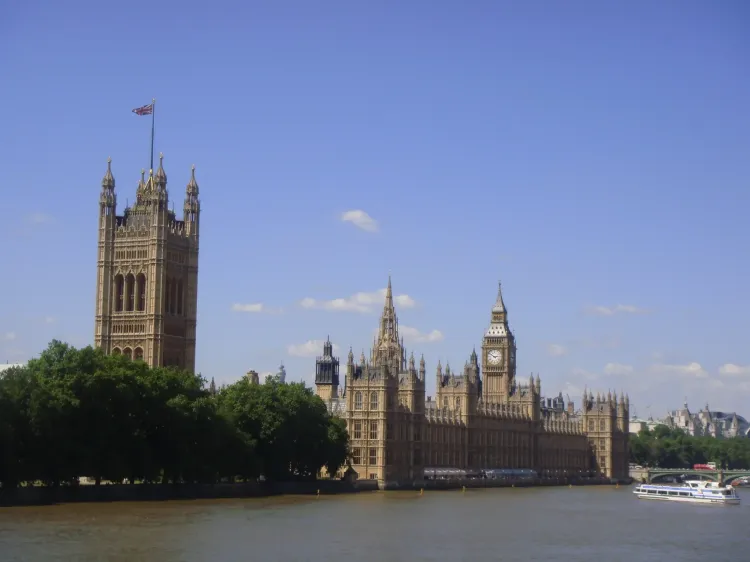What Led to the East India Company's Financial Crisis? (From the Archives)

Synopsis
Key Takeaways
- Intense Parliamentary Scrutiny: The East India Company's financial practices faced rigorous examination in the House of Commons.
- Dividend Legality: Questions arose over the legality of dividend payments amidst claims of no clear profits.
- Growing Debt: The Company’s escalating debt burden raised alarms among Parliament members.
- Imperial vs. Commercial Roles: The debates highlighted the conflict between the Company's commercial enterprise and its imperial responsibilities.
- State Intervention: The scrutiny paved the way for increased parliamentary control over the Company.
New Delhi, Nov 9 (NationPress) As the renewal of its charter approached in 1813, the financial practices of the East India Company became a focal point of vigorous and often heated discussions in the House of Commons. Members of Parliament meticulously examined the Company's financial statements, questioned its fundraising strategies, and disputed the legality of its dividend distributions.
The discussions highlighted profound concerns regarding the Company's financial stability, its connections with the state, and the intricate overlap between its commercial activities and its role as a territorial ruler. Central to this debate were three interrelated issues: the distribution of dividends without evident profits, the mounting debt burden, and the unclear relationship between business ventures and the expenses of empire.
The Dividend Controversy: Legitimacy of Profits and Borrowing
A prominent accusation against the Company's directors was their distribution of dividends to shareholders, allegedly contravening parliamentary statutes. Parliamentarian Mr. Creevey, a notable critic, consistently raised this concern, claiming that foundational laws, including acts from the reigns of William III and Queen Anne, strictly prohibited dividend payments except from "net profits". He asserted that the Company lacked such profits, asserting it was "fifteen million worse than nothing".
According to Creevey and his allies, the Company resorted to "old tactics" and, when those failed, secured £1.5 million from the government under the pretense of financing its trade, only to use the funds to distribute a dividend of £630,000. Lord Folkestone echoed this sentiment, indicating that the Company's own records revealed a shortfall of over seven million pounds after accounting for its capital stock, making dividend payments from "net proceeds" infeasible.
Lord A. Hamilton expressed disbelief that the directors could find "no profits to pay the public," as required by law, yet appeared to have "ample resources to pay themselves".
In defense, the Company’s supporters strongly contested these claims, labeling them as "unjust and baseless in both law and fact". Their argument hinged on the important distinction between the Company's dual identities as a commercial enterprise and a territorial governor. Mr. Adam, representing the Company, asserted that under the Act of 1793, the directors acted "entirely in accordance with the law". He articulated what he called the "grand fundamental principle": that the governance of India was conducted by a commercial entity, and it was "both their right and obligation to distribute dividends from their business profits".
Supporters like Mr. Grant argued that critics mischaracterized the Company as a mere private merchant, neglecting its extensive assets. He maintained that the "entire territorial property of the company, along with its assets and other holdings," should be accounted against its debts.
Moreover, he claimed the Company’s future resources were not deteriorating but rather improving. Others contended that territorial expenditures naturally consumed a portion of commercial profits, yet the Company remained obligated to pay dividends, benefiting public service. However, this rationale did not appease critics, who viewed the separation of accounts as a convenient fiction to obscure overall insolvency and evade parliamentary regulations.
Debt, Revenue, and the Cost of Empire
Beyond the dividend discussions, Parliament faced the Company's escalating debt. The "East India Company's Bonds Bill" aimed to empower the Company to secure an additional £2 million on its own credit. This proposal faced immediate backlash. Critics pointed out the irony that while the Company's revenue surged from seven million to fifteen million pounds, it had no surplus, and its bond debt continued to rise. They demanded a clear and comprehensible account of the Company's financial situation before consenting to such a measure, with Mr. Creevey vowing to demonstrate that the Company was "six million worse than nothing".
In defense, Mr. R. Dundas, President of the Board of Control, contended that the bill was not intended to augment the Company's total debt but rather to facilitate a transfer of debt from India to England. He presented this as a wise financial strategy to pay off creditors in India, where the Company faced interest rates of eight to ten percent, by borrowing in England at a mere five percent. He further justified the Company's financial status by pointing to several favorable developments:
- A recent surplus of £300,000 to £400,000, where a deficit had been anticipated.
- A reduction of interest on the Indian debt from 8-10 percent down to 6 percent, achieved under Lord Minto's management, saving £500,000 annually.
- The fact that establishments in India had not been downsized due to ongoing military missions and disturbances, with costs largely borne by the Company.
However, some members, such as Sir H. Montgomery, remained skeptical, attributing the Company's financial troubles to its own "extravagance in trade speculation and its wasteful fundraising methods". He cautioned that the directors would soon need to address £12 million in bills within the year.
The Burden on the British Public
The financial debates peaked as the broader relationship between the Company and the British state was examined. Mr. Creevey contended that since its shift from a trading entity to a territorial sovereign in 1765, the Company had become a "constant burden and grievance to the nation". He pointed to the 1793 agreement, portraying it as a total failure for the public. The key provisions of that act had been ignored:
- The Company was supposed to pay £500,000 annually to the public, but had only fulfilled this obligation once in 19 years. Instead, the public had been compelled to lend the Company £1.5 million.
- The external debt in India, which was meant to decrease from eight to two million, had instead ballooned to thirty million.
- The bond debt escalated from two to seven million pounds.
- A guarantee fund of £12 million, intended to secure the Company's capital stock, had received no contributions.
Another long-time supporter of the Company, Mr. Charles Grant, defended it by claiming that the £500,000 annual payment had been more than compensated by the "various expenditures they had made on behalf of the government". This argument, however, only highlighted the critics' position: the Company's finances were intricately linked with, and frequently subsidized by, the state, despite its charter obligations to the contrary.
The financial conduct of the East India Company, as revealed in these parliamentary records, was characterized by a fundamental conflict between its commercial mandate and its imperial duties. While its advocates defended the legality and prudence of its actions within a complicated and unprecedented framework, its detractors perceived a mismanaged entity, failing in its obligations, and surviving only through creative accounting and the financial backing of the British public. These discussions ultimately shaped the context in which the Company's charter was renewed, paving the way for increased state oversight and the eventual dismantling of its commercial monopoly.
Conclusion
This parliamentary scrutiny served as the definitive public examination of the East India Company’s structural contradictions. The debate, far exceeding a simple audit, represented a confrontation between the realities of expensive imperial governance and the strict limitations of commercial law. The Company's failure to reconcile the soaring costs of its territorial sovereignty with the statutory requirement to pay dividends exclusively from 'net profits' exposed the inherent legal contradictions and financial instability at the core of its hybrid nature.
While defenders accurately cited the vastness of the Company's assets and the expenditures it undertook on behalf of the Crown, critics like Mr. Creevey effectively illustrated that the foundational promise of the 1793 Act—a profitable partnership for the British public—had failed, supplanted instead by persistent financial dependency. The necessity of parliamentary intervention to permit further borrowing validated the critics' contentions: the Company was solvent solely by the grace of the British state.
Ultimately, this intense scrutiny provided the political and legal justification for the state to intervene more decisively. The parliamentary inquiries of 1812 and 1813 did not lead to the Company's immediate dissolution, but they constituted a final judgment on its autonomy. By revealing the financial entanglements and the magnitude of its debt, the debates laid the groundwork for the greater assertion of parliamentary control in the 1813 Charter Act, establishing the precedent for the eventual dismantling of the Company’s commercial monopoly and the gradual, inevitable shift from Company rule to direct Crown administration.
(The author is a researcher specializing in Indian History and contemporary geopolitical affairs)









